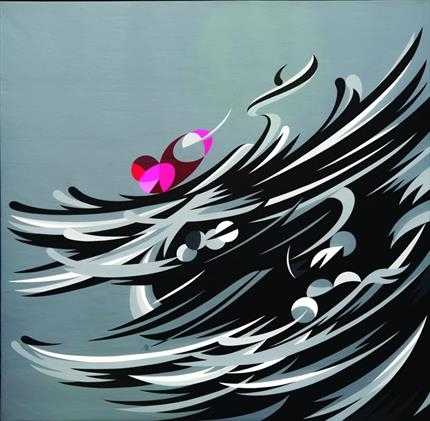About Amir Sadegh Tehrani
Amir Sadegh Tehrani carries his hometown as his last name. Tehrani is a calligrapher, graphic artist, and of the calligraphic painting movement. He started his artistic work with calligraphy; He joined the Iran Calligraphers Association and started learning Nastaliq and cursive Nastaliq scripts. He graduated from this association in 1984. Since 1985, he has been working in the Calligraphers Association as a teacher of cursive Nastaliq. Later, he went to the Faculty of Fine Arts at Tehran university to continue his studies and studied graphics until 1993 and received a bachelor's degree. In 1995, Tehrani exhibited his works individually in Tehran Barg Gallery for the first time. His next solo exhibition was a year later at Seyhoun Gallery in Tehran. In 2010, Tehrani won the International Calligraphy Biennale Honor Award in Qazvin. In his career, he has won other honors and awards, among which we can mention the plaque of honor of the International Calligraphy Festival at the Museum of Contemporary Arts in Tehran in 2000, the plaque of honor from the International Festival of the Islamic World at the Museum of Contemporary Arts (1997), the plaque of honor from The great Bismillah Festival, Arsbaran Cultural Center (1996), the honor roll of the first Experimental Painting and Graphics Biennale in Tehran (1992). Also, his works were published in two books, Jan-e-Jahan (in Nastaliq script) and Divan of Hafez (in Nastaliq script), in 1999 and 2009.
The traces of this artist's record in the calligraphy community and his academic education can be clearly identified in his calligraphic paintings. His paintings are on the border between calligraphy and graphics. The rules of calligraphy in his works have a high consistency, and the calligraphy, the combination of letters, and their arrangement also have a high richness. In his calligraphic paintings, the letters sit side by side and gradually become abstractions due to repetition and combination until the language loses its semantic connotations and reveals its nature as a visual and executive element. Tehrani's color choices and painting method are also rooted in his graphic view of calligraphic painting.
The Most Expensive Artwork
At Auctions
First Attendance
22 May 2012
# Attendance
6
# Artworks
6
Average Realized Price
6,978 USD
Average Min Estimate
4,463 USD
Average Max Estimate
5,961 USD
Sell-through Rate
100%
Average Growth of Artwork Worth
33.942%
Timeline
The 24th Tehran - Contemporary Iranian Art auction
3 October
10s of Artworks, 10s of Millions exhibition
8 March
Treasure 1 exhibition
22 July
دوازدهمین دوره حراج تهران auction
17 January
هشتمین دوره حراج تهران auction
12 January
سومین دوره حراج تهران auction
30 May
دومین دوره حراج تهران auction
28 May
اولین دوره حراج تهران auction
22 May
Amir Sadegh Tehrani exhibition
11 November
